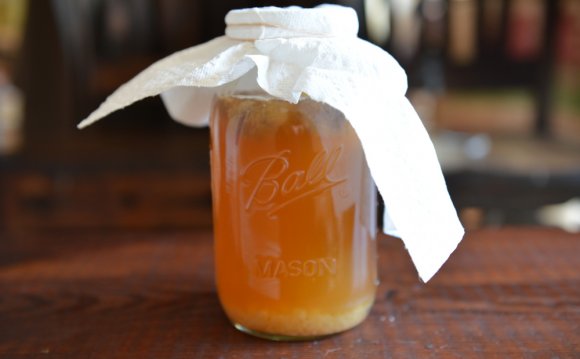
Water kefir grains are a symbiotic culture of bacteria and yeast held in a polymer created by the bacteria. Water kefir grains feed off sugar to produce lactic acid, acetic acid, various other acids, and carbon dioxide.
By culturing sugar water using the water kefir grains, you are creating a lacto-fermented drink. Lacto-fermentation is the process where lactobacilli (lactic acid producing bacteria) convert sugars or starches into lactic acid. Lactic acid is a natural preservative that prevents the growth of harmful bacteria. Used in traditional cultures to preserve foods, lacto-fermentation creates a food teeming with probiotics, good yeasts, and increased nutrient values. The synthesis of lactic acid and other acids often increases vitamin values, including vitamin C and various B vitamins.
Kefir provides dozens of beneficial bacteria and yeast strains that can benefit your body. Your body is inhabited by billions and trillions of bacteria, yeast, and other microorganisms. By taking in beneficial bacteria and yeasts, you increase the population of good bacteria in your system; beneficial bacteria in your gut make up a large part of your immune system and help you defend against harmful organisms, bad bacteria and viruses.
Making Water Kefir
To make 1 quart of water kefir, add to a quart sized glass jar:
- 4 to 5 tbsp of sucanat, rapadura, sugar, agave nectar, or maple syrup (honey will work but I don’t recommend honey as it is antibacterial and will slowly kill the grains)
- 1 tbsp of water kefir grains
- about 1 quart of filtered or spring water (enough to fill jar while leaving 1/2 to 1 inch of space at the top)
To make a larger quantity, simply scale the ingredients. The ratios for 1 gallon are:
- 1 to 1 1/4 cup (20 tbsps) of sucanat, rapadura, sugar, agave nectar, or maple syrup
- 3 to 4 tbsp of water kefir grains
- about 1 gallon of filtered or spring water (enough to fill jar while leaving 1/2 to 1 inch of space at the top)
Optional – you can add fruit and other ingredients to flavor your water kefir, such as:
- Ginger and lemon slices
- Berries, sliced in half
- Dried fruit such as figs or dried pineapple ring
Shake or stir until the sugars are completely dissolved. Cover with a non-air tight lid (most screw on lids are fine) and allow to brew at room temperature for 24 to 48+ hours. I recommend for the first couple of batches, that you taste the water kefir every 12 hours after the first day. If it’s too sweet, let ferment longer. If you forget and it’s too sour, dilute with juice or sweetened tea when drinking.
When the water kefir’s done, strain the grains out, discard any fruit you’ve added and store the finished water kefir in the fridge in a covered jar or in airtight bottles. Decanting into airtight bottles while the brew is still slightly sweet and allowing to brew in the airtight bottles for a few hours at room temperature will yield a fizzy drink. Do not bottle in airtight bottles while the brew is too sweet or too much pressure may build up and you may end up with kefir soda all over your counters when you open the bottle.
Note: It is not recommended to brew the kefir in a metal or plastic container as metal is reactive and the acidic nature of kefir may wear down and leach plastic into your brew. Avoid letting the kefir grains come in contact with metal utensils. Do not rinse or brew grains in chlorinated water as chlorine may damage or kill your grains.
Growing the Kefir Grains
The water kefir grains will grow better in a high-mineral environment. Using high mineral sweeteners such as sucanat, rapadura, or adding a bit of molasses to your brew will help your grains grow faster. I use only sucanat, and my grains double each batch. If your grains are not growing and you want them to, brew one or two rounds with only sucanat, rapadura, or with some added molasses. Some juices are also high mineral and work well for growing your grains.
Storing the Grains
When you are not making water kefir, you can store your grains in a glass jar with anywhere from double to several times the amount of liquid as grains. Add one or two tbsps of sugar to feed the grains. You may store it at room temperature or in the fridge. If storing at room temperature, change out the liquid for new water and sugar every 2 to 3 days. If storing in the fridge, you can go up to a week or two. If storing in the fridge, the first brew that you make from the grains may take a bit longer since the bacteria and yeasts will take awhile to become active again.
Water Kefir Recipes
These are some recipes I created. Have fun with your grains, experiment, and adjust to your taste!
Alcohol Content
Water kefir can contain anywhere from .2 to 2% alcohol with a 48 hour fermentation. To put it into perspective, wine is usually 7 to 15% alcohol. The alcohol content in water kefir varies widely depending on the type and amount of sweetener added, amount of grains, and fermentation time. A higher ratio of sugar will yield a more alcoholic drink, as will a shorter fermentation time. If you are alcohol sensitive, I would recommend using less kefir grain to sugar water ratio and doing a longer brew, tasting periodically.









